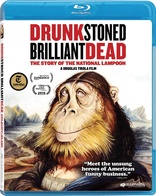Drunk Stoned Brilliant Dead: The Story of the National Lampoon Blu-ray Movie
HomeDrunk Stoned Brilliant Dead: The Story of the National Lampoon Blu-ray Movie 
Magnolia Pictures | 2015 | 95 min | Not rated | Apr 19, 2016Movie rating
6.6 | / 10 |
Blu-ray rating
| Users | 0.0 | |
| Reviewer | 3.5 | |
| Overall | 3.5 |
Overview
Drunk Stoned Brilliant Dead: The Story of the National Lampoon (2015)
A look at the history of the American comedy publication and production company, National Lampoon, from its beginning in the 1970s to 2010, featuring rare and never-before-seen footage.
Starring: Chevy Chase, John Landis, Al Jean, Mike Reiss, Tony HendraDirector: Douglas Tirola
| Documentary | 100% |
Specifications
Video
Video codec: MPEG-4 AVC
Video resolution: 1080p
Aspect ratio: 1.78:1, 1.33:1
Original aspect ratio: 1.85:1
Audio
English: DTS-HD Master Audio 5.1 (48kHz, 24-bit)
Subtitles
English SDH, Spanish
Discs
50GB Blu-ray Disc
Single disc (1 BD)
BD-Live
Playback
Region A (B, C untested)
Review
Rating summary
| Movie | 3.5 | |
| Video | 4.0 | |
| Audio | 4.0 | |
| Extras | 3.5 | |
| Overall | 3.5 |
Drunk Stoned Brilliant Dead: The Story of the National Lampoon Blu-ray Movie Review
Kenney's Klowns
Reviewed by Michael Reuben April 22, 2016National Lampoon ceased publication in 1998, but the magazine's influence has so thoroughly
permeated American culture that it never really went away. NatLamp didn't invent raunchy
humor or a general disrespect for authority, but it recast and synthesized them into a uniquely
anarchic sensibility guided by an underlying intelligence. What else would you expect from a
magazine founded by Harvard graduates?
Director Douglas Tirola (All In: The Poker Movie) has
crafted a lively documentary chronicling
the history of NatLamp through a combination of interviews and generous helpings from the
magazine's pages. The film's title, Drunk Stoned Brilliant Dead (or "DSBD"), is borrowed from
a 2010 book about the magazine by illustrator Rick Meyerowitz, a NatLamp contributor who is
one of the interviewees. Meyerowitz also created the one-sheets for DSBD, which recall his
iconic artwork for the poster of National Lampoon's Animal
House, the first of the organization's
ventures into filmmaking. The title aptly captures the perilous combustibility of the fractious
personalities that, during a relatively brief period when they managed to function effectively as a
group, redefined humor for the late 20th Century.
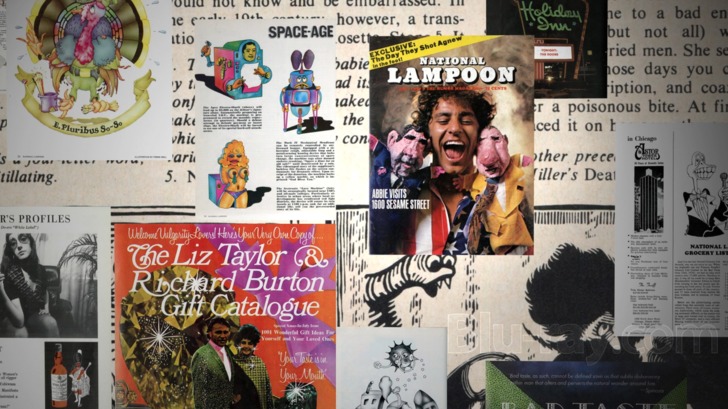
NatLamp was founded in 1969 by former members of the Harvard Lampoon, a venerable but insular college humor magazine. The primary movers were Doug Kenney and Henry Beard, but by all accounts, it was Kenney who best embodied NatLamp's combination of cutting intelligence with a kid's delight in being naughty (former NatLamp editor PJ O'Rourke describes this mix as "A students with D-minus sex lives"). Kenney and Beard brought to the world of national publication the same dorm room work ethic that had served them in college, and NatLamp became famous for its riotous, drug-fueled disorganization.
Fortunately for Kenney and Beard, they had found in publisher Matty Simmons a Chairman and CEO who was willing to let them run wild, as long as they produced work that was funny. Over the next five years, NatLamp became the destination of choice for the young, hip and rebellious, attracting an array of talent and launching multiple careers. In addition to PJ O'Rourke, NatLamp's illustrious alumni include: the late John Hughes, writer/director of The Breakfast Club and Sixteen Candles; Al Jean and Mike Weiss, now producers of The Simpsons; Anne Beatts and Michael O'Donoghue, who became top writers for Saturday Night Live; Chris Cerf, a major contributor to Sesame Street; John Weidman, who would go on to write numerous Broadway musicals, including three with Stephen Sondheim; and British comic Tony Hendra, who co-starred in This Is Spinal Tap. The organization's expansion into live shows and radio broadcast brought in Ivan Reitman, future director of Ghostbusters, as well as performers Bill Murray, John Belushi, Chevy Chase, Gilda Radner, Christopher Guest and Harold Ramis. John Landis joined the NatLamp universe as the director of Animal House.
Tirola interviews most of those who are still alive (Guest and Murray are notably absent). The result is a vivid portrait of barely controlled chaos that could not withstand its own success. NatLamp scored its highest circulation with the November 1974 issue entitled "Pubescence". By the following year, the organization was already bleeding talent. In 1975, producer Lorne Michaels raided both the writers' room and the performing ensemble to create his new late-night comedy show, Saturday Night Live. By 1978, the organization had persuaded Universal Studios to greenlight a script by Kenney, Ramis and staff writer Chris Miller based on Miller's college experiences. The runaway success of Animal House turned out to be both a blessing and a curse, redirecting the attention of the magazine toward Hollywood and generating sophomore slump pressures that hit Kenney particularly hard when his second film, 1980's Caddyshack, turned out to be less than a blockbuster.
Kenney did not live to see Caddyshack become a beloved classic on home video. He died at age 33 barely a month after the film's release. The official cause was a hiking accident in Hawaii, but suicide (or murder) is suspected. Besides providing a history of NatLamp, Tirola's film serves as a memorial to Kenney, who wrote much of the magazine's copy during its formative years and whose friends and colleagues still miss him. (Chevy Chase considered Kenney his best friend and is the most overtly emotional of the group.) After Kenney's death, the magazine struggled to remain relevant during the Eighties in the face of declining circulation and financial losses. By 1992, it was publishing only one or two issues a year, but the talent it had nurtured had spread out everywhere.
Drunk Stoned Brilliant Dead: The Story of the National Lampoon Blu-ray Movie, Video Quality 
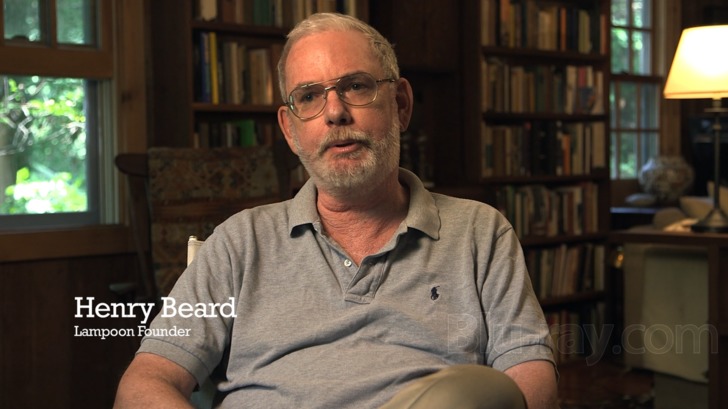
Drunk Stoned Brilliant Dead was photographed digitally by a team of cameramen led by Sean
Price Williams (Iris). Because director Tirola wanted
something more visually interesting than
the usual cluster of talking heads, most of the interviews have been framed as long shots. Instead
of magnifying the subject's expression, the camera catches his or her surroundings, usually at
home or in the office. Tirola wanted to create a contrast between who these people were (as seen
in photos and period film and video) and how they appear now. The interviews are interspersed
and overlaid with excerpts from the pages of the National Lampoon, which have been graphically
animated. All of these sources were harmonized on a digital intermediate, from which Magnolia
Home Video's 1080p, AVC-encoded Blu-ray was presumably sourced.
The Blu-ray image is excellent: sharp and detailed, with naturalistic colors that flatter both the
printed excerpts and the varied surroundings of the interviewees. The success of Tirola's effort to
create visual energy with his shots and editing rhythms are well-served by the clarity of the Blu-ray image. The vintage clips suffer by comparison,
but that is an unavoidable limitation of the
sources. The film has been mastered on a BD-50 with a high average bitrate of 33.40 Mbps.
Drunk Stoned Brilliant Dead: The Story of the National Lampoon Blu-ray Movie, Audio Quality 

DSBD's 5.1 soundtrack has been encoded in lossless DTS-HD MA and, as is usually the case with documentaries, it is functional and straightforward. The interviews are clear, intelligible and anchored to the front center. The surround array is utilized for the musical accompaniment, with scoring by Bryce Jacobs (Drive Hard) and, more memorably, a careful selection of period pop hits that underscore the wistful nostalgia that can be heard in the undertones of many of the speakers as they recall their glory days. The selections include David Bowie's "Changes" and "Jean Genie"; Dave Mason's "Only You Know and I Know"; Kenny Loggins' "I'm Alright"; and, over the closing credits, the theme song from National Lampoon's Vacation, "Holiday Road" written and performed by Lindsay Buckingham.
Drunk Stoned Brilliant Dead: The Story of the National Lampoon Blu-ray Movie, Special Features and Extras 
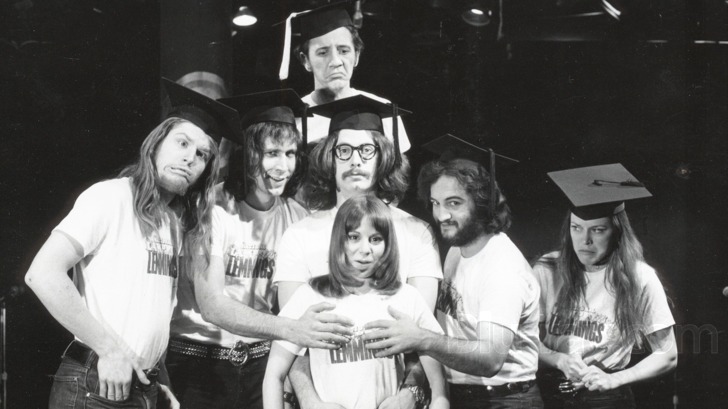
- Additional Interview Footage (1080p; 1.78:1; 22:27): A "play all" function is included.
- Tony Hendra Sings Magical Misery Tour
- Mike Reiss "National Lampoon Goes to the Movies"
- Stan Lee
- Henry Beard
- Sean Kelly
- PJ O'Rourke
- Tony Hendra
- Michael Simmons & Meatloaf & Peter Kleinman
- Judd Apatow
- John Goodman Reads Doug Kenney (1080p; 1.78:1; 1:18): The reading is from Kenney's article "First Blow Job".
- Thoughts on Animal House (1080p; 1.78:1; 10:17): Ivan Reitman, Kevin Bacon ("Diller"), Karen Allen ("Katy"), Martha Smith ("Babs"), Stephen Furst ("Dorfman"), Tim Matheson ("Stratton") and John Landis relate personal anecdotes about making the film.
- Drugs in the Office (1080p; 1.78:1; 2:04): This is an early assembly of a deleted scene featuring recollections of NatLamp's heavy drug use.
- Jaws 3 People 0 (1080p; 1.78:1; 1:56): Another deleted scene featuring director Joe Dante; after the success of Animal House, publisher Matty Simmons wanted to do a Jaws parody.
- Working in NYC (1080p; 1.78:1; 1:09): Remembering New York in the early Seventies.
- Thoughts on SNL (1080i; 1.78:1; 2:11): Further discussion of SNL's origin.
- Favorite National Lampoon Pieces (1080p; 1.78:1; 3:02): Al Jean, PJ O'Rourke, John Weidman, Peter Kleinman and Joe Dante pick their personal favorites.
- Reading John Hughes—Beverly D'Angelo, Kevin Bacon, Stephen Furst, Anthony Michael Hall & Chevy Chase (1080p; 1.78:1; 7:12): Director Tirola is a Hughes fan and had many of his interviewees read excerpts from Hughes. Only one of Kevin Bacon's readings survived the editing process.
- Artists of the National Lampoon (1080p; 1.78:1; 3:39): Further comments by the illustrators and cartoonists.
- Chevy Chase "Seeds" Story (1080p; 1.78:1; 2:16): A story about Rodney Dangerfield during the making of Caddyshack.
- Also from Magnolia Home Entertainment: The disc includes trailers for Steve Jobs: The Man in the Machine, Sunshine Superman, The Wrecking Crew and Best of Enemies, as well as promos for the Chideo web service and AXS TV.
- BD-Live: As of this writing, attempting to access BD-Live produces the message "Check back later for updates".
Drunk Stoned Brilliant Dead: The Story of the National Lampoon Blu-ray Movie, Overall Score and Recommendation 
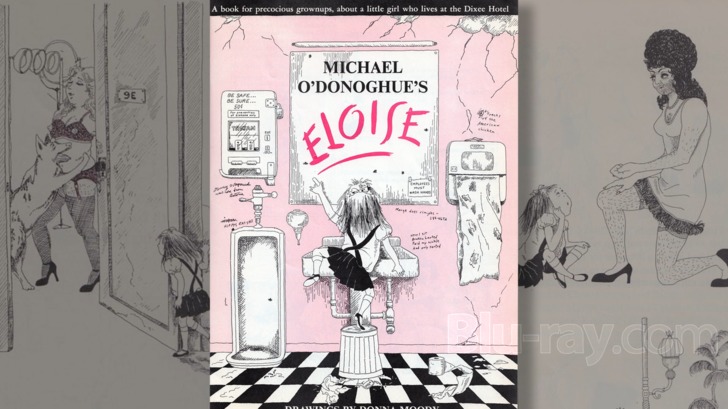
After the demise of NatLamp as a magazine, its name became the property of a licensing
corporation, which has degraded the brand by attaching it to a string of amateurish comedies
devoid of the wit that made the original publication distinctive (e.g., National Lampoon's The
Legend of Awesomest Maximus). It's an unfortunate development to which Tirola's film is a
belated but welcome antidote. DSBD is a reminder of what made Kenney's and Beard's original
creation a success. Highly recommended.
Similar titles
Similar titles you might also like

Fahrenheit 11/9
2018

RBG
2018

Where to Invade Next
2015

Waiting for "Superman"
2010

The Kid Stays in the Picture
2002

I Am Chris Farley
2015

Dawson City: Frozen Time
2016

We Are X
2016

Studio 54: The Documentary
2018

I Am Not Your Negro
2016

Best of Enemies
2015

The Dog
2013

Prohibition
2011

American Experience: Freedom Riders
2011

The Decline of Western Civilization
1981

Inside Job
2010

Hoop Dreams
1994

De Palma
2015

Raiders!: The Story of the Greatest Fan Film Ever Made
2015

Whitey: United States of America V. James J. Bulger
2014
